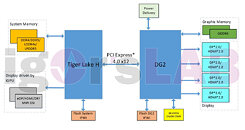Intel is preparing to flood the market with its Xe GPU lineup, covering the entire vector from low-end to high-end consumer graphics cards. Just a few days ago, the company has announced its Iris Xe MAX GPU, the first discrete GPU from Intel, aimed at 1080p gamer and content creators. However, that seems to be only the beginning of Intel's GPU plan and just a small piece of the entire lineup. Next year, the company is expected to launch two GPU families - Xe-HP and Xe-HPG. With the former being a data-centric GPU codenamed Arctic Sound, and the latter being a gaming-oriented GPU called DG2. Today, thanks to the
GeekBench listing, we have some information on the Xe-HP GPU.
Being listed with 512 EUs (Execution Units), translating into 4096 shading units, the GPU is reportedly a Xe-HP variant codenamed "NEO Graphics". This is not the first time that the NEO graphics has been mentioned. Intel has called a processor Neo graphics before, on its Architecture day when the company was demonstrating the FP32 performance. The new GeekBench leak shows the GPU running at 1.15 GHz clock speed, where at the Architecture day the same GPU ran at 1.3 GHz frequency, indicating that this is only an engineering sample. The GPU ran the GeekBench'es OpenCL test and scored very low 25,475 points. Compared to NVIDIA's GeForce RTX 3070 GPU that scored 140,484, the Intel GPU is at least four times slower. That is possibly due to the non-optimization of the benchmark, which could greatly improve in the future. In the first picture below, this Xe-HP GPU would represent the single-tile design.



















